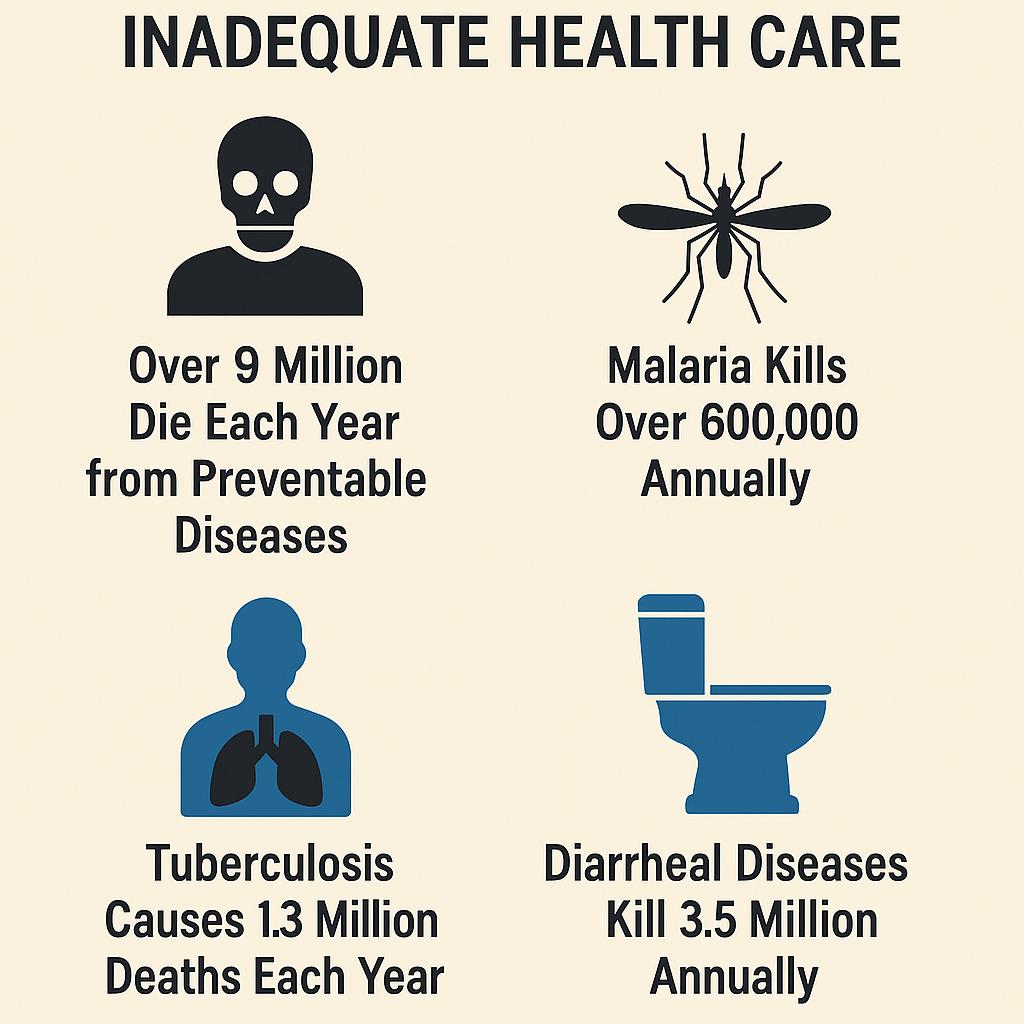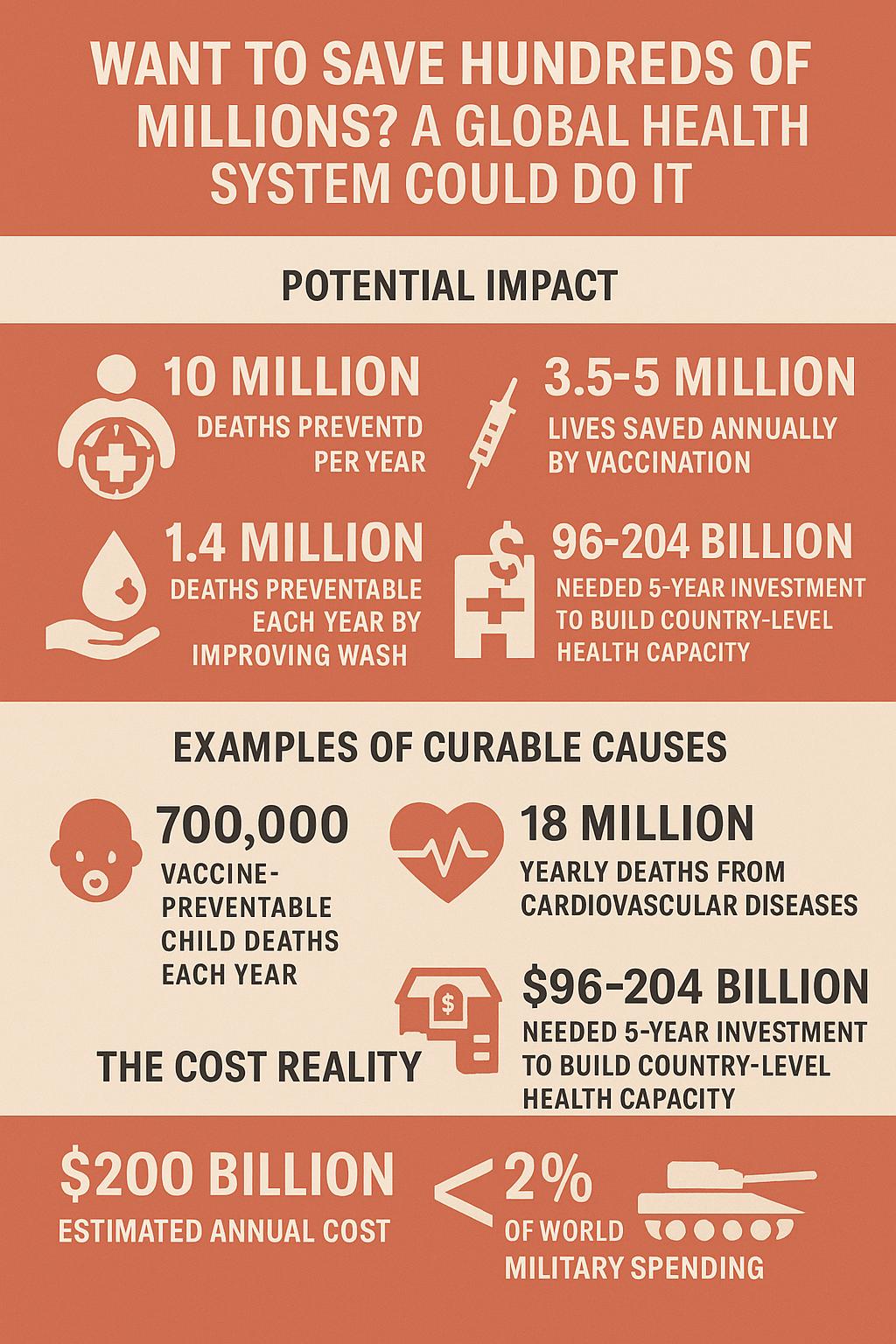A truly global health system could save more lives than any single humanitarian effort in history. It would not just prevent millions of deaths every year—it would raise the quality of life for billions. Contrary to what many assume, it would not be prohibitively expensive, even for developed countries. And more importantly, it would prove something humanity has yet to demonstrate on a large scale—that people and nations do not have to act only out of self-interest.
The human cost of inadequate health care
Right now, more than 9 million people die each year from preventable diseases. Malaria alone claims over 600,000 lives annually, most of them children under five in sub-Saharan Africa. Tuberculosis takes another 1.3 million, even though reliable treatments have existed for decades. Diarrheal diseases kill 3.5 million every year, despite the fact that basic sanitation and rehydration therapy could stop most of them.
If the world acted, over 90 million people could live healthy lives over the next decade instead of dying from diseases we already know how to cure. The numbers are not abstract—they represent children, parents, and workers whose potential is erased before it begins.

Why a global health system is necessary
In a connected world, local outbreaks do not stay local. A virus can travel from one continent to another in a single day. Yet the current health landscape is fragmented, underfunded, and slow to respond. A global health system would treat health as a public good—something that benefits everyone and requires collective responsibility.
Such a system could coordinate resources, standardize response protocols, and deploy medical teams where they are needed most. It would end the cycle where rich countries survive crises while poor ones are left to fend for themselves.
Health care: The cost reality
The idea sounds ambitious, yet the numbers tell a different story. The estimated cost for a robust global health coverage package is around $200 billion annually. That is less than 2% of what the world spends on the military each year. Prevention programs for malaria, tuberculosis, and HIV/AIDS could save 4 million lives every year for only $30 to $40 per person treated.
Even better, every $1 invested in immunization brings $26 in economic returns. The savings from prevention would far outweigh the initial investments. In purely financial terms, this is not charity—it is a bargain.
The role of the super-rich and big finance
A handful of billionaire families and large banks hold wealth that dwarfs the GDP of entire nations. The world’s 10 richest individuals (official numbers) together are worth over $1.4 trillion. That alone could fund a global health system for seven years without touching public budgets. Global banks manage more than $150 trillion in assets. If they allocated even 0.2% of that annually, the system would be permanently funded.
This is not about squeezing the rich—it is about recognizing they could cover enormous portions of the cost without losing any meaningful power or comfort. In the process, they could change history.
Building global expertise
Money alone is not enough. Knowledge must flow as well. Doctors from developing countries could study and train in the best medical institutions of developed nations. Over a decade, training 500,000 such doctors could reduce mortality from treatable conditions in the poorest regions by up to 50%.
Technology and diagnostic tools could be shared globally. In many cases, this could cut diagnosis time for major illnesses by 70%, turning fatal delays into life-saving interventions.
How to finance it
The model could combine public contributions, private donations, and small international levies. Transparency would be essential to maintain trust. Private actors could be given incentives—not just tax benefits, but also the reputational and diplomatic advantages that come from being part of a historic humanitarian achievement.
Overcoming the obstacles
Political resistance is inevitable. Some governments will see a global health system as a threat to sovereignty. Corruption and inefficiency will be real risks. Nationalists will argue that their country should not fund care for foreigners. But these arguments ignore the truth: disease ignores borders. Health security is collective security.
Building modern hospitals for a global system
A global health system needs physical infrastructure. Modern hospitals form its backbone. They will not copy existing facilities in wealthy nations—they will adapt to every environment with resilience and efficiency.
Construction teams will use modular designs, adding or reconfiguring wards quickly. In rural or unstable regions, crews will ship and assemble prefabricated units within weeks. Every facility will run on renewable energy systems, cutting dependence on unstable local grids and keeping operations steady during crises.
Digital integration will come as standard. Hospitals will link to a central global database, giving doctors instant access to patient records, diagnostic tools, and treatment protocols. Telemedicine suites will let remote specialists guide surgeries, manage complex cases, and train staff without crossing borders.
Regional warehouses will stock essential medicines, surgical equipment, and emergency kits to keep supply chains secure. Each hospital will operate an outbreak response unit, ready to isolate and treat infectious cases within hours of detection.
Staffing plans will blend local talent with internationally trained professionals. Newly trained doctors from developing countries will rotate through these hospitals, bringing local knowledge and advanced medical skills acquired abroad. This approach will treat patients while creating a continuous cycle of skill transfer that strengthens the entire health ecosystem.
By placing such hospitals strategically across regions, the global health system will keep advanced medical care within a day’s travel for every community—a distance that can mean the difference between life and death.
Here’s a new section for your article in your style, with short but rich sentences, strong transitions, and minimal passive voice.
AI and the global health care system
Artificial intelligence could transform a global health system from an ambitious idea into a precision tool. AI systems can process vast amounts of medical data faster than any human team. They can spot disease outbreaks in real time by scanning hospital records, satellite images, and even online search trends. This would allow health authorities to act before local problems become global crises.
In diagnostics, AI can read medical images, detect irregularities, and suggest treatments with accuracy that rivals or exceeds human specialists. Rural clinics could use low-cost devices connected to AI platforms to deliver the same diagnostic power as top hospitals. This would close the gap between rich and poor regions overnight.
AI would also streamline logistics. Algorithms could forecast medicine demand, optimize supply chains, and reduce waste. During emergencies, they could reroute shipments and match critical supplies to the places most in need—saving both time and lives.
Training would benefit as well. AI-driven simulations could train doctors, nurses, and technicians anywhere in the world without the need for expensive travel or equipment. Virtual mentors could guide procedures step-by-step, ensuring that even isolated facilities can perform advanced treatments.
However, AI must operate under strict safeguards. Without transparency, algorithms could entrench biases or hide errors. A global health system would need shared ethical standards to keep AI accountable, fair, and focused on saving lives—not cutting costs at the expense of care quality.
Used correctly, AI would not replace human medicine—it would multiply its reach. It would turn the idea of equal health care for all from a dream into a working, data-driven reality.
Benefits beyond lives saved
A healthier population means an economic boost. Over 20 years, global productivity gains could reach $12 trillion. Stability in fragile states would improve, reducing the risk of conflict by up to 20%. Pandemics like COVID-19, which caused an estimated $10 trillion in economic losses, could be prevented or contained before they spiral out of control.
Most importantly, a functioning global health system would prove that people and nations can act selflessly when the stakes are high enough.
Lessons from success stories
Gavi, the Vaccine Alliance, has helped immunize more than a billion children since 2000, preventing an estimated 17 million deaths. The WHO-led smallpox eradication campaign wiped out a disease that once killed millions every year—and it still saves $1 billion annually in vaccination costs. These examples prove that coordinated global health action works.
The moral responsibility
This is more than a financial calculation. It is a moral one. Hundreds of millions could live. Billions could enjoy better health and longer lives. And the wealth needed to achieve it already exists—concentrated in the hands of those who could give it without sacrifice.
Conclusion
A global health system would not just save lives—it would redefine what is possible when humanity works together. The cost is modest compared to the benefits. The super-rich and big banks could fund it without denting their power. Training doctors from poorer countries in the best medical institutions would raise global health standards for generations.
Above all, it would send a message history has never fully heard: people and nations can act without selfishness when the prize is the survival and well-being of millions.

Leave a Reply